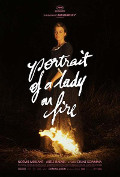
France 2019
Directed by
Celine Sciamma
121 minutes
Rated MA
Reviewed by
Bernard Hemingway

Portrait Of A Lady On Fire
Synopsis: It’s the late 18th century and Marianne (Noémie Merlant), a professional portraitist, has accepted a commission to paint Héloïse (Adèle Haenel), the finished painting being intended for Héloïse’s prospective husband, a Milanese nobleman, in order to seal their marriage as arranged by Héloïse’s mother (Valeria Golino). There’s only one problem, Héloïse refuses to sit for her portrait.
Artistically and intellectually France dominated the 18th century and it is a century that the French do particularly well in film. Writer-director Céline Sciamma’s Portrait of a Lady on Fire is a fine instance of this – elegant yet elemental, restrained yet passionate, evoking the period with convincing authenticity yet retaining a modern sensibility.
Well-aided by her cinematographer, Claire Mathon, Sciamma delivers her story with stripped back means, setting it in a largely unfurnished rural chateau on the rugged shores of the wind-swept Brittany coast, thereby concentrating our attention on the relationship between the two principals – the portraitist, an independent, capable woman who, unusual for the day has taken over her father’s profession, and her subject, a somewhat younger woman (for some reason the “jeune” or “young” is omitted from the film’s English title), who has known only convent life yet who has enough native intelligence to bristle at her mother’s albeit well-meant plans to marry her off.
Having seen the trailer for this film multiple times I was somewhat surprised by the ease with which the portrait was painted but this is precisely where the substance of the story really kicks in. Although Marianne is perfectly satisfied with her work Héloïse challenges her for not have captured her spirit. Realizing the truth of this Marianne destroys the painting and starts again this time with Héloïse’s co-operation. But as the latter points out while Marianne observes her, she is observing Marianne. And so the two women fall passionately in love.
Sciamma, whose script won Best Screenplay at Cannes, uses the act of painting as an economical device to play out the drama of love with its joy and sorrow. The lot of a young housekeeper (Luana Bajrami) is deftly included as a more conventional counterpoint but also a facilitator of and co-conspirator in the illicit romance. This relationship produces one of the film’s stand-out scenes at a local village festival, where women gather round a bonfire and sing an a capella rondo based on a Latin phrase which means “we cannot escape”. The implications, both positive and negative, are apparent.
In the leads Merlant and Haenel are both marvellous as they play out the shifting impulses of their characters’ polymorphous libidoes, sometimes feminine and enveloping, sometimes masculine and penetrative, this dialogue of emotions coming to fruition in a candid portrayal of their physical relationship.
The film has a coda which refers back to some of the elements of the main story. I was not convinced that this was necessary, particularly given the effort expended but more generally because the scenes lacked the visual simplicity that so had beautifully served Sciamma hitherto. I could even have done without the pillow talk that closes off that main part of the film. A more rigorous cut would, I suspect, have given the film greater heft and one feels that these scenes were included to make the film more rewarding to the paying public. Which perhaps explains why French art cinema is not what it used to be.
Want something different?





